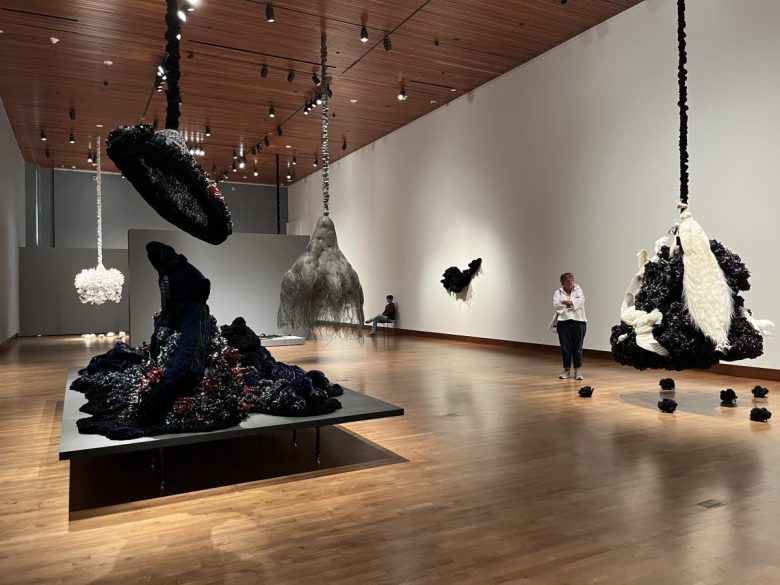
“Petah Coyne’s Maximalist Art Exposes the Realities of Women’s Oppression”
## Unveiling Petah Coyne’s *How Much A Heart Can Hold* at the Chazen Museum of Art
### Exploring Female Oppression Through the Lens of Maximalist Art
**MADISON, Wisconsin** — Women throughout history have navigated the complexities of societal expectations that often trap them in beauty standards and cultural practices, subtly or overtly diminishing their agency. From the sartorial constraints of corsets and heels to the more profound burdens of ritualistic roles as wives or daughters, these impositions have long been normalized in everyday life. However, some artists, like Petah Coyne, have dedicated their careers to confronting these injustices, often through the very aesthetics that symbolize them. In her latest exhibition, *How Much A Heart Can Hold* at the Chazen Museum of Art, Coyne tackles the nuanced and pervasive forces that marginalize women.
At age 71, Coyne has remained committed to her distinctive style—a boundary-pushing maximalism that uses opulent materials like flowers, velvets, and pearls to engage the viewer in a visceral confrontation with the hidden costs of female beauty and societal roles. The exhibition spans works created between 1997 and 2023, showcasing Coyne’s ability to spark emotional unease through her impressive, larger-than-life sculptures that straddle the line between abundance and suffocation.
### The Sculpture of Seduction: Beauty as a Tool for Uncomfortable Truths
Upon entering the exhibition, visitors are engulfed in a dimly lit, baroque-like space, where Coyne’s sculptures tower over them, casting a shadow that makes one feel small yet significant. The first section of the show, *Women’s Work*, opens with an impactful piece, “Untitled 1378 (Zelda Fitzgerald)” from 1997 to 2013. Ensconced in flowers, pearls, and velvet, the sculpture immediately confronts the viewer with its collapse into itself—a sugary extravagance that has spoiled. Here, Coyne pays homage to Zelda Fitzgerald, a woman whose potential as a writer was often eclipsed by her famous husband. As if inside a symbolic glass vitrine, the piece captures the inevitability of decay, suggesting that no matter how much women give, they remain trapped within social bounds that constrain their creative and personal freedom.
Continuing this theme, Coyne’s “Untitled #1568 (Zora Neale Hurston)” and “Untitled #1411 (Jane Austen)” expand upon the representation of well-known women writers, celebrating their defiance against societal limitations. These are not mere tributes; they evoke a sense of the eerie, where flowers represent more than beauty or success—they bloom, rot, and fall. Hurston’s piece, dominated by a vine-covered fence festooned with flowers, marks both the growth and barrier women experience, while Austen’s chandelier-like bouquet of wax formations calls forth both joy and sorrow, a duality often present in Coyne’s feminist themes.
### Exploring Myth and Mortality: Hair, Ghosts, and Female Archetypes
The exhibition’s second section, *Women Obscured & Transformed*, delves deeper into more abstract but no less powerful themes concerning the loss of identity and the embodiment of ghosts from the past. “Untitled #720 (Eguchi’s Ghost)” (1992–2007), an imposing, spectral sculpture suspended from the ceiling and resembling a massive tangled wig, is particularly striking. The viewer is confronted with what seems like a thick rope of disheveled, gray hair, an inescapable reference to the loss of individuality that many women endure as time strips them of their youth and societal value. This eerie combination of repulsion and magnificence typifies Coyne’s method—overwhelm the senses to unearth a deeply buried discomfort.
One of the most viscerally unsettling works in this section is “Untitled #918 (Kawabata)” (1997–1998). Comprising mounds of horse hair intricately braided on a pedestal, the piece confronts the viewer with the duality of sexual and social innocence associated with girls and young women. Braids—a traditional symbol of youth and innocence—are twisted and warped, calling into question whether adherence to these nostalgic images is a form of entrapment. Indeed, the seduction of innocence may be one of the most insidious methods societies deploy to suppress a woman’s individuality.
### The Final Chapter: Women’s Relationships
The exhibition culminates in the third and final segment, *Women’s Relationships*. This section presents perhaps the largest piece in the show, “Untitled #1379 (The Doctor’s Wife)” (1997–2018), an abstract, coiled arrangement of dark velvet fabrications. This artwork evokes the monotonies and rigid expectations of women consigned to domesticity—the fabric coils resembling the quiet, repetitive labor that continues in the shadows of patriarchal structures. The eye is drawn to